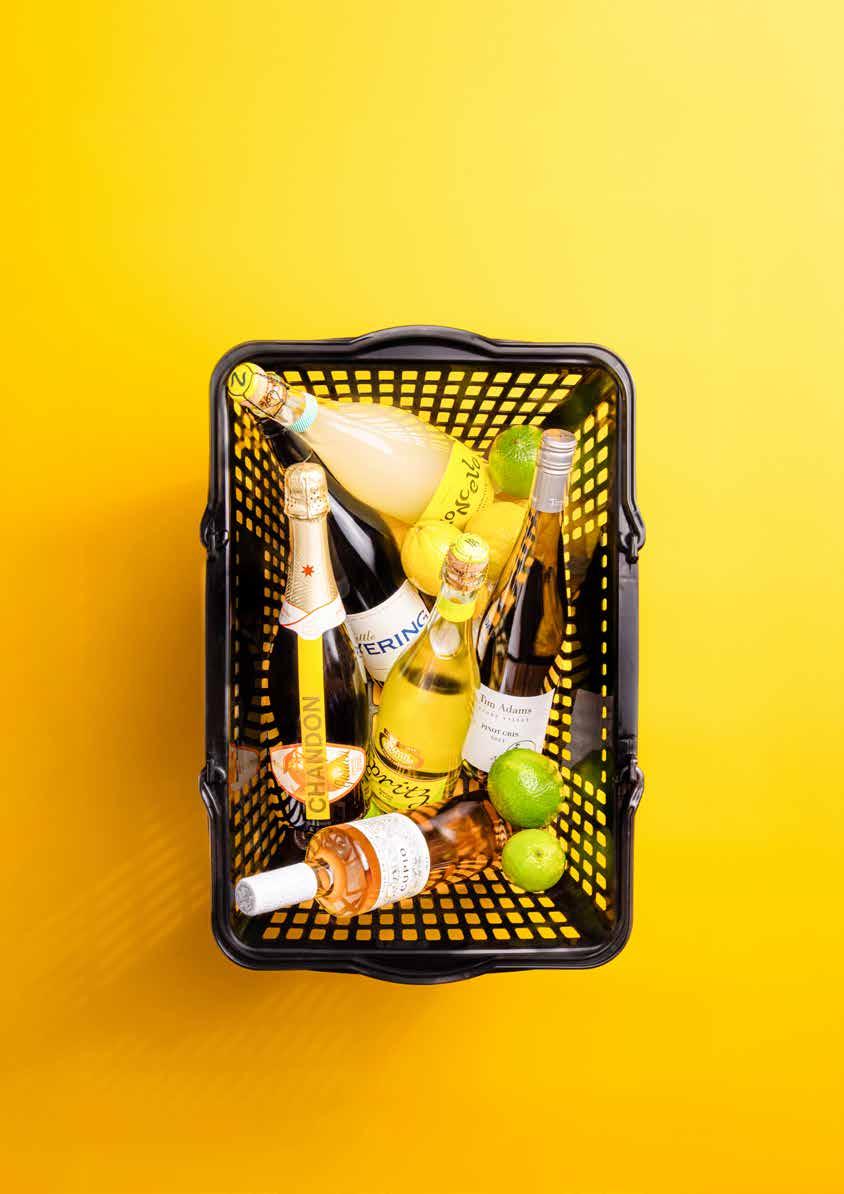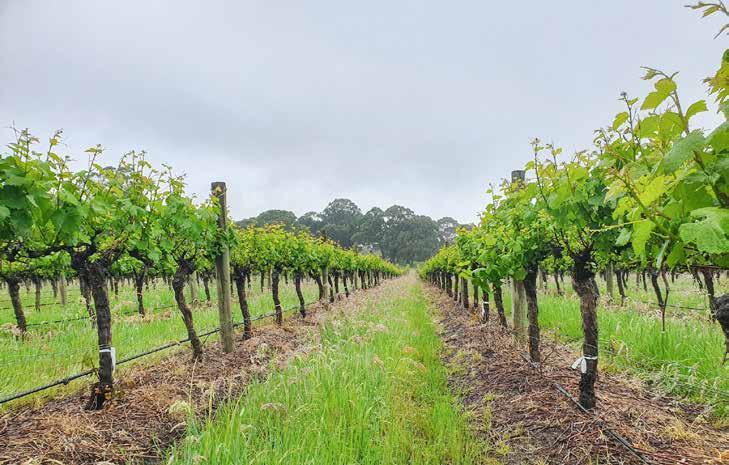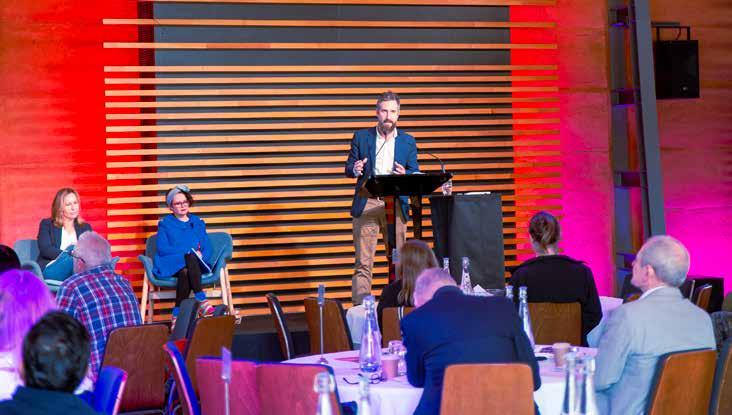GETTING ID’d WHO IS THE AUSSIE CONSUMER? THE






Cover: Front and centre of our September issue is the ‘State of the Grapes’ report, released by Endeavour Group (owners of Dan Murphy’s and BWS) and Wine Australia, which breaks down the data of domestic wine sales. In the vineyard, we learn about infrared frost fighting technology from Europe, and researchers at Charles Sturt University investigate scale insect management. Ian Jeffery explores the degradation of cooling system compressors in wineries, and we hear from two separate wine regions concerned about the impact of proposed mines on their business.
Cover image: Kera Wong Photography
6 What’s online
6 In this issue
14 International briefs
90 Producer Profile: Xavier Bizot
92 Looking Back
92 Calendar
93 Marketplace classifieds


7 The Institute of Masters of Wine postpones 11th International Symposium in Adelaide
8 Semillon sings at Hunter Valley Wine Show as producers celebrated with top awards
9 TWE expects $50 million impact from loss of California distributor
10 McLaren Vale winery buys Fox Creek Wines to “safeguard” legacy
11 De Bortoli to develop taste-profiling tool in collaboration with Melbourne University students
12 Scholars announced for 2025 Len Evans Tutorial
13 Support released for small businesses affected by drought in South Australia
15 Analysis: Concerns raised over the Wine Australia Strategic Plan 20252030
17 Analysis: Wine Australia counters concerns about its Strategic Plan
89 Daily Wine Views
20 FEATURE Scale insect pests in vineyards
26 Lighting the way: Cutting-edge infrared tech mitigates frost damage
30 Shedding further light on infrared frost protection
34 Wine industry fears its concerns over mining projects are being ignored
40 Nearly $8 million awarded to boost viticulture and horticulture drought resilience
44 Evolving varieties provide a fresh take on Rutherglen
WINEMAKING
46 FEATURE Tackling winery refrigeration compressor degradation
52 Martinborough winery releases wine made in rare native timber
54 Behind the Top Drops: Henschke Hill of Grace Shiraz
BUSINESS & TECHNOLOGY
64 FEATURE Charles Sturt celebrates five decades of Wagga Wagga winery
66 AWITC and WineTech: ‘Upbeat’ sector comes together
72 Wine business workplace briefs
SALES & MARKETING
74 FEATURE “Not just fleeting trends” Endeavour reveals wine sales insights in new report
80 Who is the Australian wine consumer?
84 FEATURE Serving Singapore: Tasmania seeks to grow international presence as growth tipped to quadruple
86 New recycle-ready bag-in-box packaging launched for wine



The Institute of Masters of Wine (IMW), in partnership with Wine Australia and the South Australian government, has postponed the 11th International Symposium, originally scheduled to take place in Adelaide from 12-15 November 2026. The new dates for the symposium will be 15-18 April 2027.
The announcement follows a further delay to the decision over whether COP31, the United Nations Climate Change Conference, will be hosted in Adelaide, with a conclusion now not expected until at least November this year. Should Adelaide be selected as the host city, the venue and dates would be the same as those originally planned for the symposium, forcing the IMW event to be rescheduled or cancelled.
The IMW International Symposium is one of the world’s leading gatherings for wine professionals, attracting Masters of Wine, industry leaders, producers and
communicators from across the globe.
IMW said it was a “difficult decision”, but that postponing would “provide the necessary certainty for delegates, partners and the planning committee to ensure that the Adelaide symposium remains a stand-alone, world-class event”.
The IMW acknowledged that the new April 2027 dates are likely to coincide with harvest and vintage in some regions, which presents its own set of challenges.
“Unfortunately, more suitable dates were not available,” said the IMW, “but the IMW will collaborate closely with its partners to deliver an outstanding and inclusive event despite these challenges.”
“Postponing a flagship event is never an easy decision,” said interim IMW executive director Sarah Harrison.
“However, our priority is to protect the quality and accessibility of the symposium for our global community. We are grateful for the continued support
of our Australian partners and look forward to welcoming the world’s wine professionals to Adelaide in 2027 for what promises to be an exceptional event.”
South Australian Minister for Trade and Investment, Joe Szakacs, said the State Government has been working closely with the IMW.
“The new dates provide certainty and allow for proper planning for both organisers and attendees, so that the global wine industry can truly experience one of the best wineproducing states in the world,” said Minister Szakacs.
“We look forward to welcoming participants to Adelaide, Australia’s Great Wine Capital.”
Further details about the symposium, including the programme, ticket sales and regional trips, will be announced in early 2026.

Dr Anthony Borneman, The Australian Wine Research Institute
In the July 2025 issue of Grapegrower & Winemaker, Dr Chris Bourke presented a history of the MV6, Pommard and Abel clones, while referring to genetic studies that were performed at the AWRI in collaboration with Adelaide Hills Vine Improvement Inc. as described in a 2022 Grapegrower & Winemaker article by Prue Henschke and myself.
I enjoyed Dr Bourke’s description of the history of the vines, however I would like to address some instances where the genomic data as presented in the 2022 piece were either misinterpreted or over-interpreted – which, given the technical nature of the data is very easy to do. With the benefit of experience in the analysis and access to additional, as yet unpublished, genetic data, I’d like to clarify some of the conclusions that were made with respect to the Pinot pedigree and the MV6, Pommard and Abel clones.
1. The Mount Pleasant selections (MV6, Mt Pleasant and AHVID4V2) do not have a close genetic
relationship with the “Pommard” material (D4V2, UCD05). The details of the branching near the centre of the pedigree as shown in 2022 are generally unreliable and do not support any conclusions around their relationship.
Subsequent Pinot pedigree work that has been performed at the AWRI since 2022 has also clarified that the MV6 and Pommard genetic groups are as unrelated as any two other genetic groups within the Pinot pedigree. There is also no genetic relationship to suggest that AHVID4V2 is either MV4 or MV5 (or a mix of the two).
2. While clones 114 and 667 do share a genetic link, clone 115 is not within a genetic group with these two clones.
3. As correctly pointed out by Dr Bourke, the Abel material that was sequenced (from Australian sources) is genetically related to the Mariafeld,
D2V5 and D2V6 clones, which share their origins in Wadenswil, Switzerland.
However, the positioning of Abel within the Mariafeld genetic group does not totally preclude this material from being genetically related to vineyard material from within the Domaine RomaneeConti vineyard or the broader Burgundy region. Indeed, additional pedigree work has shown that Australian “Bourgogne clones”, which have origins supposedly in Burgundy but which came via Switzerland1, are the most closely related material to the Abel clone sequenced to date.
In the end, the only way to know for sure would be to investigate the genetics of the Domaine Romanee-Conti plantings from which the Abel cutting was supposedly taken, as well as further examples of the Abel clone from throughout New Zealand, including the Ata Rangi vineyard, which contains the oldest surviving plantings of this clone.
Refrigeration
Engineering consultant Ian Jeffery addresses ways to identify and remedy what can be a major electrical energy cost drain for winery operations.

Adecade ago, industry body Meat & Livestock Australia determined that refrigeration compressor degradation was leading to huge electrical energy costs and waste. Supported by the Australian Government, which provided 50 per cent of its funds, they engaged NSW-based Minus40 Consulting Engineers to assess refrigeration compressor degradation and develop a wear mitigation strategy.
Minus40 concluded that, “Wear occurring in industrial screw compressor is a long-ignored subject which can potentially result in significant avoidable energy consumption and reduce refrigeration plant operating efficiency. This study illustrates the principles of compressor wear and its causes and lack of recoverability by compressor rebuild”.
Furthermore, it found that “an on-site compressor performance test procedure has been developed and used to examine 54 compressors within seven different sites to obtain an understanding of typical wear conditions of industrial compressors”¹.
First, let us first discuss the costs of excessive electricity consumption measured by Minus40. In 2014, the consultancy reported excessive electricity consumption of three selected compressors as $102,000, $40,000 and $65,250 respectively. These costs are based on 2014 electrical energy costs of between 12-15 cents per kWh – today’s costs are possibly 50%-100% higher.
Following their work for Meat & Livestock Australia, the NSW Government Office of Environment and Heritage engaged Minus40 Consulting in 2017. The engagement was to produce a guide for the whole spectrum of Australian enterprises to assist in choosing, planning and managing energy and cost saving refrigeration opportunities.
The resultant 100+ page ‘I am your industrial refrigeration guide’ identified 10 of its 15 innovations of value to the wine industry¹.
● Compressor degradation can quietly inflate winery energy bills by $40k–$100k+ per unit.
● Many winery screw compressors show significant wear after 10–15 years of vintage use.
● On-site testing reveals hidden inefficiencies—essential for informed upgrade decisions.
● Worn compressors leak refrigerant internally, reducing cooling capacity during vintage.
● Oil breakdown during vintage leads to carbon and metal buildup—like sandpaper inside your compressor.
● Upgrading oil filtration can extend compressor life by 25–50%, preserving operational reliability.
● Variable speed drives can cut refrigeration energy use by up to 15%—ideal for peak vintage demand.
● Predictive maintenance using oil sampling helps avoid midvintage breakdowns.
● Screw compressors don’t fully recover efficiency after rebuild—replacement may be the only fix.
According to Minus40’s 2017 assessment, partly optimised refrigeration plant, which was identified as “applicable to most wineries,” had total potential energy savings of 18 per cent. ‘Un-optimised’ energy-inefficient refrigeration plant –applicable to “a significant number of wineries” – had total potential energy savings of 48%.

Endeavour’s State of the Grapes report, released in late July in conjunction with Wine Australia, takes a closer look at which Australians are buying wine through its BWS and Dan Murphy’s channels, presenting an illustrative profile of the range of wine consumers through purchasing data. The answers may or may not surprise you – according to State of the Grapes nearly two thirds of wine purchases are made by women, affluence entirely outranks local industry presence, and Riesling crops up as an outlier in a number of trends.
Almost all wine photography shows wine with food, and yet we know that this is a declining occasion set.
Endeavour has been talking about “occasion sets” for some time now, but it was not until August this year, when the company released its inaugural State of the Grapes report in collaboration with Wine Australia, that the rest of the industry was able to see the data as plainly. The report provided an abundance of useful and fascinating data, such as state-by-state breakdowns of consumer preference, insights into the preferences of different generations, and the incredible sway of affluence when it comes to consumption choices.
At Wine Australia’s market update at the end of July, attendees were privy
to a preview of the State of the Grapes report, with further insight provided by Endeavour team members Tim Carroll, director of merchandise, Andrew Shedden, general manager of premium and luxury, and Leigh Firkin, head of commercial wine.
Paul Turale, Wine Australia’s general manager of marketing, set the scene by providing context on the current geopolitical environment in Australia and around the globe, referencing the “anti-alcohol and prohibitionist lobby” among other factors such as the pandemic and cost-of-living stressors.
Despite these pressures, Turale noted that there are still opportunities for Australian wine, and that “those opportunities remain significant”.
However, he cautioned, yesterday’s rules may no longer apply.
“We keep asking ourselves two key questions: first, how do we get drinkers in Australian wine to consider it more regularly, for more occasions? And the second question, can we engage and grow consumers—be it here in Australia or around the world—who are not drinking Australian wine, to consider it in future?
I think if we can find answers to those two questions, we’ll be on track across the future.”
The first step to answering these questions is examining who is currently buying Australian wine, where and why they are buying it, and, crucially, what occasions they are buying it for.
To answer this, Tim Carroll, director of merchandise and buying at Endeavour, took the stage.